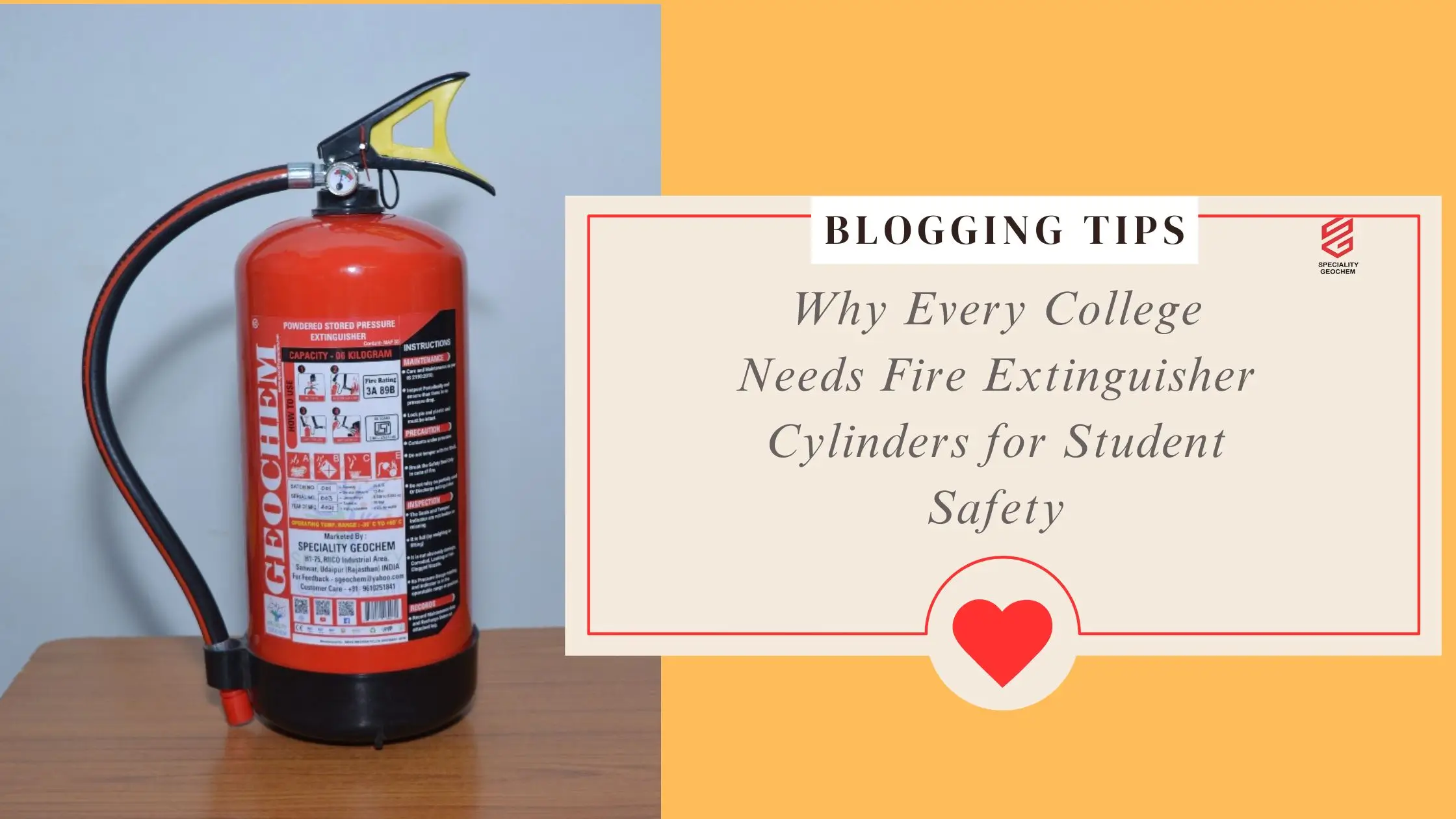Fire Extinguisher Cylinders in Colleges: Colleges and universities are dynamic spaces filled with students, faculty, and staff engaged in learning, research, and extracurricular activities. With the sheer size of campuses and the presence of laboratories, hostels, cafeterias, and libraries, the risk of fire emergencies cannot be underestimated. A single lapse in fire safety can endanger hundreds of lives within minutes. This is where installing fire extinguisher cylinders for colleges becomes not just a legal requirement but also a moral responsibility.
Fire extinguisher cylinders provide the first line of defense against sudden fires, allowing quick suppression before the situation escalates. From classrooms to dormitories, their presence ensures that every part of the college is equipped to tackle fire hazards effectively.
Importance of Fire Safety in Colleges
The significance of fire safety in colleges goes beyond regulatory compliance. Educational institutions house young adults who may not always be aware of fire hazards or trained to handle emergencies. Moreover, colleges often feature:
- Laboratories with flammable chemicals and electrical equipment.
- Libraries with thousands of paper-based materials highly prone to fire.
- Cafeterias and kitchens where cooking gas and oils are used.
- Hostels and dormitories with electrical appliances and heaters.
- Auditoriums and event halls that host large gatherings.
Each of these areas represents a unique fire risk. By installing fire extinguisher cylinders in colleges, administrators protect students, staff, and valuable infrastructure from devastating losses.
What is a Fire Extinguisher Cylinder?
A fire extinguisher cylinder is a pressurized container designed to release fire-suppressing agents such as water, foam, dry powder, or carbon dioxide. Unlike small extinguishers, cylinders are larger, durable, and suitable for environments with high occupancy like colleges. They are built to quickly tackle different classes of fires—whether caused by paper, chemicals, oils, or electrical faults.
Why Colleges Specifically Need Fire Extinguisher Cylinders
1. High Population Density
Colleges can have thousands of students on campus at any given time. In case of a fire, evacuation becomes challenging, making early intervention with fire extinguishers critical.
2. Multiple Fire-Prone Zones
Unlike offices or residential buildings, colleges have diverse fire-prone areas—science labs, canteens, hostels, and libraries. Each area requires the right type of fire extinguisher cylinder to ensure safety.
3. Regulatory Compliance
Most fire safety regulations mandate the installation of fire extinguishers in institutions. Non-compliance not only risks lives but can also lead to fines, closures, or loss of accreditation.
4. Protection of Infrastructure
Laboratories, computer labs, libraries, and auditoriums represent millions of rupees in investments. A fire can destroy years of resources, research, and infrastructure within minutes.
5. Student Confidence and Parental Assurance
Parents expect their children to be safe when they send them to colleges. A visibly strong fire safety system, including cylinders, reassures families about the institution’s commitment to safety.
Types of Fire Extinguisher Cylinders Suitable for Colleges
Different areas within a college require different types of extinguishers:
- Water Fire Extinguishers – Ideal for classrooms and libraries where wood, paper, and cloth are common.
- Foam Fire Extinguishers – Useful in cafeterias where cooking oils may catch fire.
- CO₂ Fire Extinguishers – Best for computer labs and auditoriums where electrical equipment is abundant.
- Dry Powder Fire Extinguishers – Suitable for science labs with mixed fire risks, including chemicals.
By choosing the right type of fire extinguisher cylinder, colleges can ensure comprehensive coverage across all risk zones.
Placement of Fire Extinguisher Cylinders in Colleges
Strategic placement is vital for effectiveness. Cylinders should be:
- Installed at entrances and exits of lecture halls and auditoriums.
- Placed near kitchens and canteens where fire risks are higher.
- Fixed in laboratories and workshops close to workstations.
- Kept on each floor of dormitories/hostels for quick accessibility.
- Clearly marked with signage and instructions for students.
Proper placement ensures that in case of a fire, cylinders can be accessed immediately without delay.
Training and Awareness for Students
Having fire extinguishers in place is only half the battle. Students and staff must be trained to use them. Colleges can organize:
- Fire safety drills every semester.
- Workshops on different fire classes and how to tackle them.
- Emergency response teams among faculty and students.
Awareness programs help reduce panic and ensure that extinguishers are used correctly during real emergencies.
Maintenance and Regular Inspections
Fire extinguisher cylinders for colleges must be maintained to remain effective. Key steps include:
- Annual servicing by certified professionals.
- Pressure checks to ensure no leakage.
- Replacement of expired cylinders.
- Record-keeping of maintenance schedules for compliance.
Ignoring maintenance can render even the best equipment useless when needed most.
Benefits of Fire Extinguisher Cylinders in Colleges
- Immediate Response – Cylinders allow fires to be controlled instantly before spreading.
- Life Safety – The primary benefit is saving lives of students, staff, and visitors.
- Property Protection – Protects expensive infrastructure like labs and libraries.
- Cost-Effective – The cost of installing cylinders is minimal compared to damages from a fire.
- Legal Security – Ensures compliance with fire safety laws and avoids penalties.
Case Example: A Laboratory Fire Scenario
Imagine a chemistry laboratory where a small spark ignites near flammable chemicals. Without extinguishers, this could turn into a catastrophic fire in minutes, putting dozens of students at risk. With a fire extinguisher cylinder in the lab, a trained student or faculty member can quickly put out the fire, preventing injuries and losses. This simple example highlights how critical cylinders are in the college environment.
Future of Fire Safety in Colleges
Modern colleges are moving toward integrating automatic fire suppression systems alongside extinguisher cylinders. Smart alarms, sprinklers, and IoT-enabled safety devices are becoming common. However, manual fire extinguisher cylinders remain irreplaceable due to their reliability, affordability, and ease of use.
Conclusion
Colleges are more than just academic institutions—they are thriving communities where the safety of students, faculty, and staff must always come first. Fire emergencies in cafeterias, laboratories, libraries, or dormitories can escalate rapidly, endangering lives and valuable infrastructure. Installing fire extinguisher cylinders for colleges is not just a precautionary measure but a long-term investment in protecting people and property.
By ensuring proper placement of cylinders, conducting regular inspections, and educating students and staff on how to use them, institutions can foster a culture of readiness and responsibility. Fire safety is not merely about meeting compliance requirements; it reflects an institution’s commitment to care, foresight, and the future of its students.
At Speciality Geochem, we deliver high-quality, reliable, and durable fire extinguisher cylinders designed to safeguard educational campuses. Choosing the right fire protection solution today ensures a safer, more resilient tomorrow for colleges and the generations they nurture.

